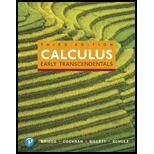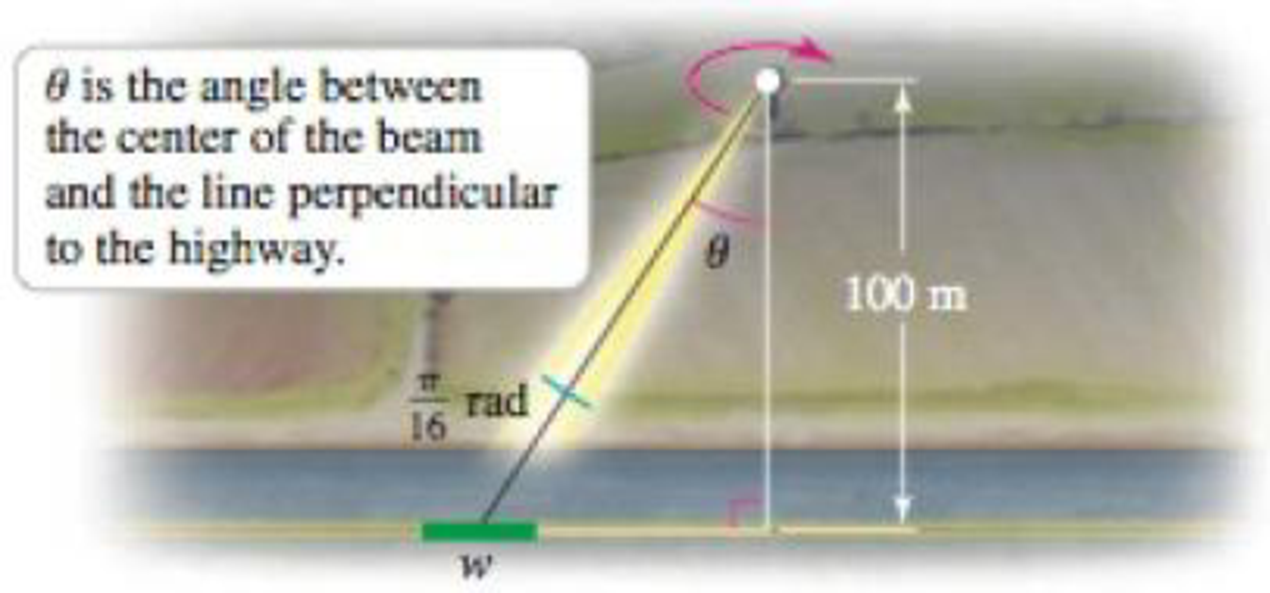
Concept explainers
Searchlight—wide beam A revolving searchlight, which is 100 m from the nearest point on a straight highway, casts a horizontal beam along a highway (see figure). The beam leaves the spotlight at an angle of π/16 rad and revolves at a rate of π/6 rad/s. Let w be the width of the beam as it sweeps along the highway and θ be the angle that the center of the beam makes with the perpendicular to the highway. What is the rate of change of w when θ = π/3? Neglect the height of the searchlight.

Want to see the full answer?
Check out a sample textbook solution
Chapter 3 Solutions
MyLab Math with Pearson eText -- Standalone Access Card -- for Calculus: Early Transcendentals (3rd Edition)
Additional Math Textbook Solutions
Basic Business Statistics, Student Value Edition
Algebra and Trigonometry (6th Edition)
A Problem Solving Approach To Mathematics For Elementary School Teachers (13th Edition)
Pre-Algebra Student Edition
University Calculus: Early Transcendentals (4th Edition)
Elementary Statistics: Picturing the World (7th Edition)
- The circular blade on a saw has a radius of 4 inches and it rotates at 2400 revolutions per minute. a. Find the angular speed of the blade in radians per minute. b. Find the linear speed of the edge of the blade.arrow_forwardOn a baseball diamond a square, the bases are 90ft apart. Use the Law of Sines to find the distance from home plate to second base. Exercises 3839arrow_forwardExpress the lengths a and b shown in the figure in terms of .arrow_forward
- Gear Trains Figure 8 shows a single-stage gear train. Gear trains are used in many products, such as clocks and automotive transmissions, to reduce or increase the angular velocity of a component. The size of each gear is measured by the number of teeth rather than the radius. Suppose the first gear has n1 and the second gear has n2 teeth. Because the spacing of the teeth is the same for both gears, the ratio of their radii will be equivalent to the corresponding ratio of the number of teeth. When two gears are meshed together, they share the same linear velocity. If 1 and 2 are the angular velocities of the first and second gears, respectively, then v2=v1r22=r112=r1r212=n1n21 The first gear in a single-stage gear train has 42 teeth and an angular velocity of 2 revolutions per second. The second gear has 7 teeth. Find the angular velocity of the second gear.arrow_forwardGear Trains Figure 8 shows a single-stage gear train. Gear trains are used in many products, such as clocks and automotive transmissions, to reduce or increase the angular velocity of a component. The size of each gear is measured by the number of teeth rather than the radius. Suppose the first gear has n1 and the second gear has n2 teeth. Because the spacing of the teeth is the same for both gears, the ratio of their radii will be equivalent to the corresponding ratio of the number of teeth. When two gears are meshed together, they share the same linear velocity. If 1 and 2 are the angular velocities of the first and second gears, respectively, then v2=v1r22=r112=r1r212=n1n21 The second gear in a single-stage gear train has 6 teeth and an angular velocity of 90 revolutions per minute. The first gear has 54 teeth. Find the angular velocity of the first gear.arrow_forward
- Algebra & Trigonometry with Analytic GeometryAlgebraISBN:9781133382119Author:SwokowskiPublisher:Cengage
 Trigonometry (MindTap Course List)TrigonometryISBN:9781337278461Author:Ron LarsonPublisher:Cengage Learning
Trigonometry (MindTap Course List)TrigonometryISBN:9781337278461Author:Ron LarsonPublisher:Cengage Learning Trigonometry (MindTap Course List)TrigonometryISBN:9781305652224Author:Charles P. McKeague, Mark D. TurnerPublisher:Cengage Learning
Trigonometry (MindTap Course List)TrigonometryISBN:9781305652224Author:Charles P. McKeague, Mark D. TurnerPublisher:Cengage Learning  Algebra and Trigonometry (MindTap Course List)AlgebraISBN:9781305071742Author:James Stewart, Lothar Redlin, Saleem WatsonPublisher:Cengage Learning
Algebra and Trigonometry (MindTap Course List)AlgebraISBN:9781305071742Author:James Stewart, Lothar Redlin, Saleem WatsonPublisher:Cengage Learning Elementary Geometry For College Students, 7eGeometryISBN:9781337614085Author:Alexander, Daniel C.; Koeberlein, Geralyn M.Publisher:Cengage,
Elementary Geometry For College Students, 7eGeometryISBN:9781337614085Author:Alexander, Daniel C.; Koeberlein, Geralyn M.Publisher:Cengage, Mathematics For Machine TechnologyAdvanced MathISBN:9781337798310Author:Peterson, John.Publisher:Cengage Learning,
Mathematics For Machine TechnologyAdvanced MathISBN:9781337798310Author:Peterson, John.Publisher:Cengage Learning,





